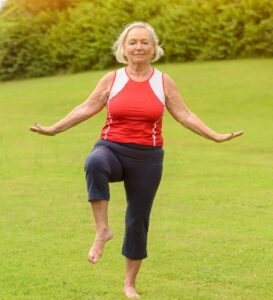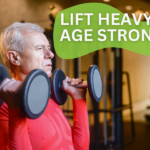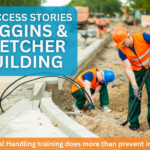This article has kindly been shared by Alison Richmond from Provention
The Balance Factor: Why “Equilibrium” is the MVP of Healthy Aging
Getting older is inevitable – but losing your independence doesn’t have to be.
Aging well is about staying strong, mobile, and confident in your movement. That’s where the F.A.C.E. method comes in.
Developed by orthopedic surgeon and healthy aging expert Dr. Vonda Wright, the F.A.C.E. framework helps you thrive into your 80s and 90s with strength and purpose. The four pillars are:
-
- Flexibility – Keep your joints mobile with stretches and yoga.
-
- Aerobic – Support heart health with walking, running, cycling, or dancing.
-
- Carry a Load – Strengthen bones and muscles through resistance training.
-
- Equilibrium – Boost balance to prevent falls and improve everyday stability.
In this final article in the F.A.C.E. series we’re looking at E for Equilibrium (a fancy word for balance) – the often overlooked key to independence and long-term health.
Why Balance Training Matters (more than you think)
Strength and cardio often get the spotlight, but balance is the real MVP – especially as we age. Why?
Because it literally keeps you on your feet.
1 in 3 older adults falls every year.
For women over 65, 50% never fully regain mobility after a serious fall. Yikes!
The good news? You can train your balance – just like you train your strength or stamina.
Better balance = fewer falls = more independence and confidence.
Easy Balance Exercises You Can Do at Home
The best part? No gym is required. Try these quick, fun hacks that fit into your daily routine:
Test Your Balance
-
- Stand on one leg for as long as you can.
-
- Too wobbly? Stand near a counter or wall.
-
- Ready for more? Try swinging your arms or the free leg.
-
- The Ultimate Pro mode? Try it with your eyes closed!
Make It a Habit
-
- Stand on one leg while brushing your teeth
-
- Alternate legs for top and bottom teeth
-
- Feeling brave? Try a gentle hop and hold the balance
The 2-Minute Challenge
Commit to just 2 minutes of balance exercises daily for one month. Track your progress – you’ll be amazed at how quickly your stability improves with consistency.
The Brain–Balance Connection
Balance isn’t just about avoiding falls – it’s about keeping your brain healthy too. Movement and coordination stimulate brain activity, helping reduce cognitive decline and even the risk of dementia.
Want more info?
Check out our article on How Exercise Can Transform Your Brain Health
Bringing It All Together: The F.A.C.E. Framework
Now that we’ve examined Flexibility, Aerobic exercise, Carrying a load, and Equilibrium, it’s clear how each contributes to aging with strength and vitality.
We hope you’re feeling inspired to take small, powerful steps toward aging well.
Remember, aging isn’t something that happens in your 70s – it starts today. So why not begin building your strength, balance, and vitality now?
Your Challenge
Take the 2-minute balance challenge every day for one month.
Then tell us how it went – we’d love to hear your success story!







